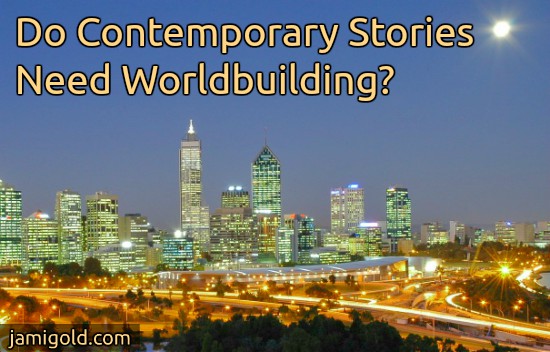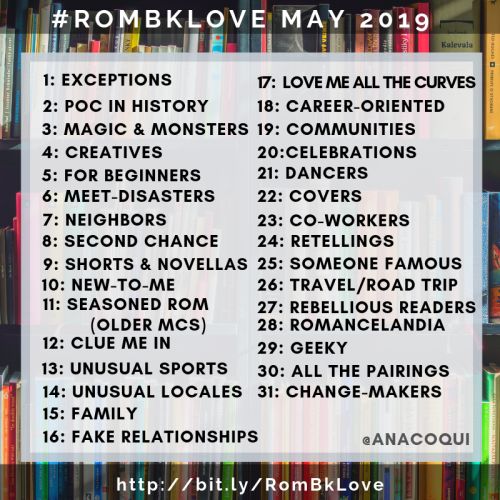Worldbuilding Is for Every Story

As a paranormal romance author, it’s easy for me to know what the term worldbuilding refers to. Everyone understands what worldbuilding is when we’re talking about fantasy, science fiction, historical, etc., but it’s harder to pin down the meaning when we discuss contemporary stories.
However, every story includes worldbuilding. Even the most “normal” setting still requires us to establish our story’s world and situation.
This month’s #RomBkLove event on social media reminded me that many of the contemporary romance stories I’ve loved featured full, immersive worldbuilding, and that insight deserves a blog post. *smile* Let’s explore what worldbuilding means for contemporary stories.
Story Immersion and Worldbuilding
A few years ago, we dug into story immersion, the sense that we’re not just reading words on a page—we’re experiencing the story. Depending on how our brain works, we might feel and see and imagine the story, or the real world around us might simply fade into the background.
Back when I first joined Goodreads in 2010, my answer to the profile question “What kind of books do you like to read?” focused on immersion—even though I wasn’t familiar with the term yet:
“I want books to envelop me in the characters’ world and keep me turning pages. To me, that means paranormal romance, urban fantasy, and historical romance, with some YA, sci-fi, and fantasy thrown in for good measure.”
Although many aspects of our story can create a sense of immersion—from premise and characters to deep point of view and emotions—my answer suggests that, for me, worldbuilding is important and necessary for immersion.
My Appreciation for Worldbuilding…
Worldbuilding is what forces me to separate my mind from my body, my imagination from the words on a page. For me, worldbuilding encompasses many of the other elements:
- interesting premises, settings, etc., of something I haven’t seen before
- provides complications and obstacles for the plot and tension
- integrates showing and characters in risky situations, as the characters explore the story world
- creates curiosity, as I try to understand the unfamiliar
- Etc., etc.
As I alluded to with my answer, for years I assumed I needed to look to fantastical, scifi, and historical stories to find that level of worldbuilding. It took me a few years, but I eventually discovered that immersion could be experienced with well-developed worldbuilding in contemporary romances as well. *smile*
Worldbuilding for Contemporary Stories
As we discussed last month, worldbuilding is so much more than we often think it to be. It’s not just about the “rules” and history of our story world, but also…
- what our characters believe about that world
- how it makes them act and react
- how characters and groups think about and treat each other
- how our characters compare to the “norm” of their situation
In other words, almost every aspect of our story contributes to worldbuilding. The dialogue our characters say, the clothes they wear, their attitude and reaction in every situation, how others react to them, the obstacles they encounter, who respects or disrespects who, etc.—everything that contributes to readers’ understanding of the story world is worldbuilding.
With that perspective, it’s easier to understand how worldbuilding applies to contemporary stories:
- Does our setting feel like a real place, complete with a population that interacts like real people?
- Is the culture or communities of our characters interesting and/or relatable?
- Is the situation our characters experience robust and layered?
I’m going to share a few examples of contemporary romance stories that have sucked me in with their immersive worldbuilding, but first…
#RomBkLove: Sharing Recommendations
Yesterday Ana Coqui kicked off the #RomBkLove event with a prompt about exceptions:
“We all have tropes or romance conventions that we can’t stand. However every once in a while…you ended up reading a book that you usually wouldn’t and somehow you end up loving it anyway.
What are your exceptions to the rule?”
Years ago, I thought I wouldn’t enjoy contemporary romances so I didn’t read them, but then I had to read @LizzieShaneAK‘s Romancing Miss Right for a contest, and I *loved* it enough to convert me to the whole sub-genre. 😍 #RomBkLove https://t.co/2Eu5XXb3RS
— Jami Gold (@JamiGold) May 1, 2019
That prompt got me thinking about this worldbuilding topic, so I want to give #RomBkLove a shout out. If you’re not familiar with the #RomBkLove event, this month Romancelandia celebrates romance books—especially stories by authors of color and authors in the LGBTQIA+ and disabled communities—by sharing recommendations for books they love. Yay!
Recommendations are based on each day’s prompt:
For each day’s prompt, the #RomBkLove team of book-ish bloggers is sharing a list of inclusive romance book recommendations. (Check Ana Coqui’s post for the details of each day’s prompt and blogger.) Then on Twitter and Instagram, readers join the discussion with their recommendations based on the day’s prompt.
What Makes Contemporary Worldbuilding Immersive?
In the years since I gave Lizzie Shane’s story a perfect 10, I’ve added several contemporary romance authors to my auto-buy list, so I’ve definitely turned into a fan. Let’s take a look at some of my favorite stories and see what aspects of their worldbuilding make them immersive…
Immersive Situation/Premise:
The story I mentioned above, Lizzie Shane’s Romancing Miss Right, was immersive to me because of the situation created by the premise. The story follows a Bachelorette-style reality show, as the heroine tries to find love.
Do contemporary stories need worldbuilding, and if so, how do we do it? Click To TweetThe details of the behind-the-scenes antics and politics of the reality show made the situation extra engaging. The reactions and obstacles felt so realistic that I would completely believe Lizzie if she said she’d worked on the production of a reality show.
Take the Lead by Alexis Daria is another reality-show story that landed on my keeper shelf. Alexis captures the behind-the-scenes of a Dancing with the Stars-style show in a realistic way as well.
In other words, we can make our contemporary stories more immersive if we include specific details that create a sense of giving our readers a behind-the-curtain look of a relatable, real-world situation.
Immersive Character Development:
Going through my keeper shelf on Goodreads, a couple of the contemporary romances on the list captured my attention because of the characters:
- Hate to Want You by Alisha Rai purposely includes some over-the-top soap-opera-style elements, yet the characters themselves felt like real people, broken and stubborn and vulnerable.
- The One You Fight For by Roni Loren is part of a series following the survivors of a school shooting. The premise shouldn’t fit with romance, but Roni makes it work with tender, insightful understanding of her characters and their powerful, honest emotions.
Deep layering of characters, giving readers the sense that they’ll learn about themselves as the characters deal with their issues, can help make a story immersive. When characters experience deep, honest insights and relatable truths, readers’ emotions resonate along with the words on the page.
Immersive Setting:
The term setting can apply to place or time, but I’m trying to focus on contemporary settings here. That said, one story on my keeper shelf that’s close to contemporary, time-wise, is Star Dust by Emma Barry and Genevieve Turner.
How can strong worldbuilding—even in a contemporary setting—make our story more immersive? Click To TweetSet in 1962, the details of the early sixties, the characters’ attitudes and interactions, and the astronaut hero’s role in the space race all created the sense of being a slice-of-life story from the real world. When I finished the book, I almost had to remind myself of the current year because I could almost smell the setting with the furniture and food choices of the era.
I’ve talked before about how stories in cultures or settings that we’re unfamiliar with can be immersive, but I want to make a point that even a more-familiar setting can be immersive. A present day story with a “normal”-yet-immersive setting as far as place is Bittersweet by Sarina Bowen.
Set in Vermont, this story focuses on an organic farmer and a wannabe chef who’s interning on a farm-to-table project for a restaurant group. I’m not a foodie by any stretch, but this story made me hungry and longing to taste the dishes dreamed up by the heroine.
My author friend Shaila Patel recommended this book to me, and we both gushed over the worldbuilding aspect of it, so I’m not alone. The descriptions of the hero’s farm made us want to schedule a trip to Vermont to pick apples.
Imagined smells, tastes, emotional insights, and experiences all hint at a stronger connection to our story. That’s the power of immersion: It makes readers experience our stories on a deeper level.
Strong, deep, and layered worldbuilding—such as with our story’s engaging situations, realistic character interactions, and we-are-there settings—can help any story feel immersive. Even the ones set in the boring, real world we all know. *smile*
Does strong worldbuilding make stories more immersive for you? Have you read contemporary stories with strong worldbuilding? What made them immersive for you? Can you think of other ways to include immersive worldbuilding in contemporary stories? Are you following the #RomBkLove event?
Pin It

Comments — What do you think?